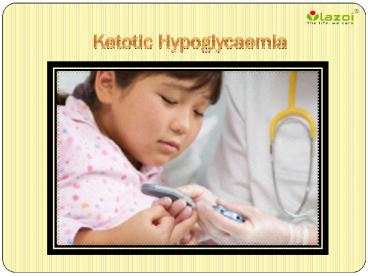Ketotic Hypoglycaemia in Children: Symptoms, causes, diagnosis and treatment - PowerPoint PPT Presentation
Title:
Ketotic Hypoglycaemia in Children: Symptoms, causes, diagnosis and treatment
Description:
Ketotic hypoglycaemia is the most common type of hypoglycaemia that affects children after the neonatal period. However, the condition resolves on its own by the time they reach adolescence. – PowerPoint PPT presentation
Number of Views:43
Title: Ketotic Hypoglycaemia in Children: Symptoms, causes, diagnosis and treatment
1
Ketotic Hypoglycaemia
2
Ketotic Hypoglycaemia
- Ketotic hypoglycaemia is the most common type of
hypoglycaemia that affects children after the
neonatal period. However, the condition resolves
on its own by the time they reach adolescence.
More commonly, children in the age group of 18
months to 5 years experience recurrent episodes
of hypoglycaemia, especially during an illness or
after fasting for a prolonged time period (more
than 8 to 16 hours). Hypoglycaemia refers to a
blood sugar level lower than 70 mg/dL. Usually,
hypoglycaemia is a complication associated with
diabetes. So, diabetic children and adolescents
can experience hypoglycaemia when they take too
much of insulin or eat too little. But, ketotic
hypoglycaemia has not been found to be related to
a specific endocrine or metabolic abnormality. It
is mainly associated with low tolerance for
fasting, and most children outgrow this condition
before they turn 8 to 9 years old. After this
age, the incidence of this type of hypoglycaemia
is quite rare.
3
What are the causes of ketotic hypoglycaemia?
- Ketotic hypoglycaemia, also known as
'accelerated starvation', is idiopathic in
nature. In other words, its causes are not known
with certainty. Basically, children with this
condition have a low tolerance for fasting. - One possible cause is a defect in
gluconeogenesis, or generation of glucose from
non-carbohydrate sources that mainly takes place
in the liver. Another suspected cause is
inadequate glycogen stores. - Ketotic hypoglycaemia is more common in children
born small for their gestational age, and those
who have a low body mass index. Therefore, it is
thought that reduced muscle mass could be the
reason behind impaired glucose production or
gluconeogenesis by the liver, that eventually
leads to hypoglycaemia.
4
What are the causes of ketotic hypoglycaemia?
- It has been observed that children born small for
their gestational age, who develop transient
neonatal hyperinsulinemic hypoglycaemia, can
later on develop ketotic hypoglycaemia as well.
Transient neonatal hyperinsulinemic hypoglycaemia
is characterised by an excessive production of
insulin, and so it is suspected that a metabolic
or endocrine problem may be associated with the
problem in some patients. - It has been observed that certain factors can
trigger an episode of hypoglycaemia. Some such
important precipitating factors include fasting
for a prolonged period skipping dinner and eating
too little, or low carbohydrate intake the
previous night illnesses like a viral
infection or stomach flu.
5
Symptoms
- Episodes of ketotic hypoglycaemia mostly occur
in the mornings, usually after a prolonged period
of fasting. Some of the most common symptoms that
this condition can produce are - Palpitations and anxiety
- Confusion
- Headaches
- Lethargy and malaise
- Unresponsiveness
- A change in behaviour
- Visual disturbances
- Slurred speech and dizziness
- Convulsions and seizures
- Abdominal discomfort
- Nausea and vomiting
6
How ketotic hypoglycaemia is diagnosed?
- This condition is diagnosed with the help of a
number of tests and examinations that help rule
out the possibility of other conditions that can
also cause hypoglycaemia with ketosis. Tests are
carried out for measuring the levels of insulin,
the growth hormone, cortisol, and lactic
acid. If the episodes of hypoglycaemia are
quite frequent, then the patient is closely
monitored during a diagnostic fast. This test
helps find out how soon the glucose levels begin
to fall following fasting, and whether the
metabolic responses to falling glucose levels are
normal.
7
Treatments
- The best way to prevent ketotic hypoglycaemia is
to avoid extended fasts and the habit of skipping
a meal. Children with this condition should be
fed small, but frequent meals and snacks,
especially before going to bed. After the usual
duration of sleep, they should be awakened and
fed properly.During an episode of
hypoglycaemia, you should immediately feed the
child a source of easily-absorbed glucose, such
as table sugar, candies, or fruit juice. If
hypoglycaemia causes vomiting, then the child
should be admitted to the hospital, where the
condition can be treated with the intravenous
administration of saline and dextrose. Diet
should include healthy and nutritious foods.
Foods with high fibre content, such as fruits,
vegetables, and whole grains, should be
incorporated in their diet.
8
Treatments
Continue
- Such type of food can ensure the release of
glucose at a slow and even pace, and thus, help
maintain the level of blood glucose. If a
hypoglycaemic child has a low body mass index,
then along with nutritious foods, the physician
may prescribe some nutritional supplements as
well.
9
CONNECT WITH US
- Logon to
- www.lazoi.com
- Like us on Facebook
- https//www.facebook.com/LazoiTheLife
- Follow us on Twitter
- https//www.twitter.com/lazoithelife
- Follow us on Pinterest
- https//www.in.pinterest.com/lazoithelife

